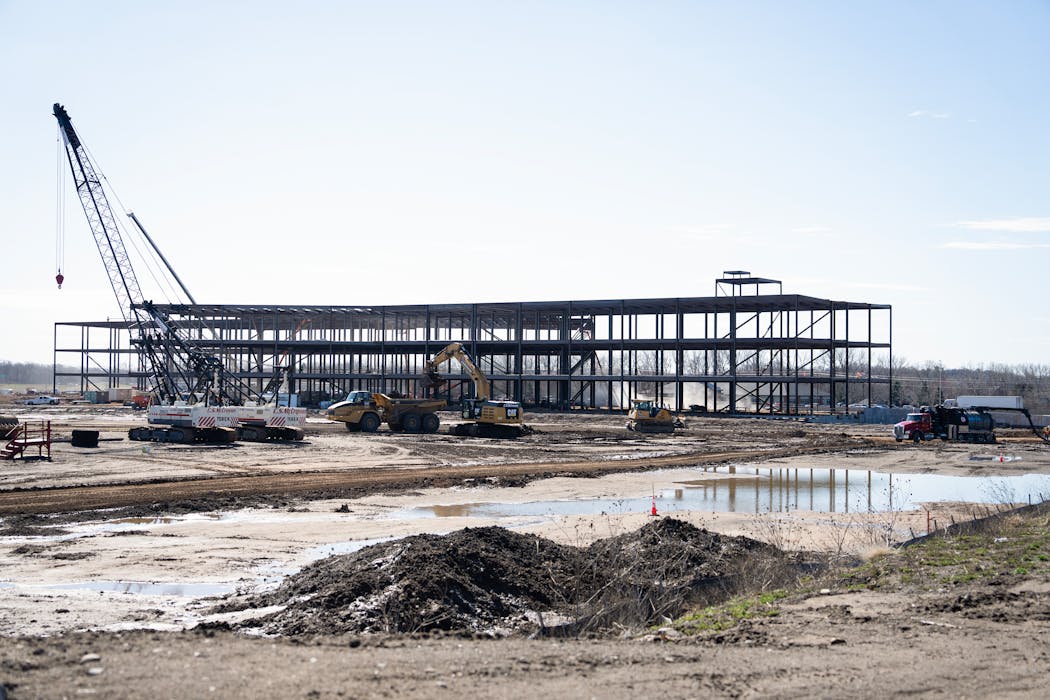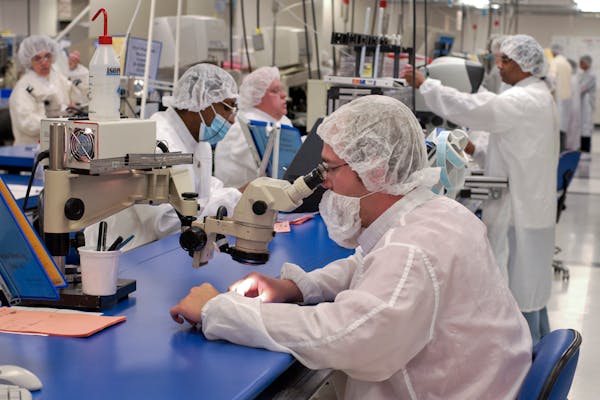The outlook for offices in the Twin Cities is no doubt dim in the hybrid-work era, but there is at least one bright spot in commercial real estate world: life sciences.
The sprawling sector includes a broad swath of companies, including med-tech firms and device manufacturers such as Medtronic. It's also a thriving part of the Minnesota economy, with the Twin Cities being one of the top areas for med-tech employment in the nation and in line for millions of dollars of federal backing.
New data proves that, showing the average building vacancy rate for the life sciences industry fell to just 3.3% in the metro at the end of the first quarter, according to commercial brokerage Colliers. At the same time, office vacancies overall stabilized but remained near record highs at 13.8% while vacancies for industrial properties increased slightly.
While office buildings from the suburbs to downtown Minneapolis are selling well below their original values, falling behind on mortgage and property tax payments or in talks for conversion into residential use, construction on more life sciences buildings is increasing. There are now several life science projects in the works or moving forward, adding hundreds of thousands of square feet of labs, production space and research facilities to a region that's especially well known for medical manufacturing.
The Twin Cities has all the essential elements to make it a life sciences stronghold, experts say, including top research universities and major medical centers like the Mayo Clinic and its recently announced $5 billion expansion. From 2018-22, the Twin Cities ranked second in the U.S. for the number of med-tech jobs and third for total venture capital funding for health care devices and supplies, according to a national JLL analysis.
"We are the original device market," said Jessica Mogilka, executive vice president at JLL. "We're the granddaddy of them all, with [Medtronic founder] Earl Bakken in his garage in northeast Minneapolis in the '50s building the pacemaker."
Massive footprints
In many ways, the surge of life sciences development happening in the Twin Cities has been long overdue.
Michael Anderstrom, associate vice president and senior adviser for the life sciences team at Colliers, said compared with the rest of the commercial real estate market, there's been a dearth of life science development in the Twin Cities. It represents only about 2% to 3% of the overall commercial market in the metro despite its prevalence as a major industry in the area.
That's perhaps because given the specialized nature of such businesses, projects are difficult and extremely expensive to build. They're also hard to repurpose, should it come to that.
Yet development is still underway. Minneapolis-based builder Ryan Cos. has cultivated a niche in the life sciences market and recently broke ground on $145 million build-to-suit project in Maple Grove. It includes a 400,000-square-foot office and research and development facility for Boston Scientific, which is the anchor tenant in the 100-acre Minnesota Science and Technology Center. This will be in addition to Boston Scientific's current Minnesota locations: another 79-acre campus in Maple Grove and a 92-acre one in Arden Hills.
"For all the reasons that Minneapolis is a good place for Fortune 500 companies, it's good for these med-tech users," said Dan Mueller, senior vice president of real estate development for Ryan.
Ryan also recently completed construction of a 42-acre Innovation Center campus in Colorado for Medtronic, including a nearly 500,000-square-foot facility with a 60,000 square feet of lab/research and development space. And in 2020, Ryan developed a 132,000-square-foot headquarters for Colder Products, which makes quick-connection couplers for med-tech and pharmaceutical companies.
Mueller said the focus on med-tech projects is especially relevant now because unlike typical commercial projects, much of the work in that industry isn't possible just anywhere.
"You need people in these facilities. It can't be done at home or in a coffee shop," he said. "You can't create cutting edge tech at home."
Flexible spaces
Part of what makes the Twin Cities' med-tech environment unique is its millions of square feet of "flex space," Mogilka said. That's mostly one-story buildings with office and warehouse capacity that device manufacturers can use in a variety of ways.
Mogilka is on the board of the University Enterprise Laboratories (UEL) a 150,000-square-foot lab space near the University of Minnesota campus. UEL is one of three purpose-built lab spaces that serve as incubators for companies readying to take the next step, per Anderstrom. That includes the 4Front Campus in Oakdale and Mortenson's Discovery Square One and Two in Rochester, all of which provide critical access to infrastructure and equipment for these fledgling companies, which could one day grow into the next Medtronic or Boston Scientific, both in terms of renown and real estate.
But before those up-and-comers are to the level of building 100-acre realms, they might be in the market for flex space.
IMRIS, which makes magnetic resonance imaging systems (MRIs) that move around on tracks mounted to the ceiling of a hospital or clinic, used to operate out of a repurposed five-story building in Minnetonka, originally built in the 1970s. But the company ended up evolving in a way the space couldn't, mainly because it was too big and ill-suited to the company's research and high-tech production needs.
"The company realized that the space we were in wasn't quite optimized for the way we were doing business," said Alan Weinberg, vice president of marketing and product management at IMRIS. "The space we're in now is optimized now for interaction."
IMRIS moved to a newly built facility in Chaska this past fall that includes office and production areas.
Just this week, North Dakota-based life sciences company Aldevron requested millions in state aid to help fund an expansion of a warehouse building the company bought in Eden Prairie in 2022.
"There's a tipping point when you evaluate a new building vs. an existing one," Mueller said. "At some point, it becomes more cost-effective to work from the inside out and craft that building around the use."
Future potential
It's not just the private sector promoting the life sciences segment: With industry backing, economic partnership organization Greater MSP is spearheading an effort to expand the region's prominence as a med-tech hub through an initiative called MedTech 3.0.
The initiative promotes collaboration between hospitals, research institutions and medical device manufacturers, among others. The group recently applied for $60 million in federal funding but plans to go ahead with or without it.
"We have so much expertise and the entire supply chain and ecosystems," Mogilka said.
Brent Webb, development executive at Mortenson, said such funding, though, is critical to promoting the kind of research and development crucial for enabling the attraction and retention of talent.
"All of these things are connected in some ways," he said.
At the end of March, the University of Minnesota Foundation selected Mortenson as its development partner for the first phase of a 12-acre "hub of innovation and economic development" called the Minnesota Innovation Exchange or "The MIX."
Webb said while the foundation still hasn't identified an anchor tenant for the first phase of the project — adjacent to the university's Biomedical Discovery District and future clinical campus expansion near Huntington Bank Stadium — he said a med-tech user is a likely component.
"The MIX in itself is creating a framework to support researchers and their ideas but also a connection to private industry," Webb said.
Webb said while the life sciences sector has been an optimistic part of the commercial real estate scene in the Twin Cities, the sector hasn't been immune to the lending woes that have dogged the rest of the industry. He said venture capital funding has been harder to come by, and many companies are focusing on investing in operations rather than expansions.
"We've seen a bit of slowdown in growth," he said. "It hasn't bounced back to where we were three years ago."
New York City turns to AI-powered scanners in push to keep guns out of the subway system
North Carolina regulators says nonprofit run by lieutenant governor's wife owes the state $132K




